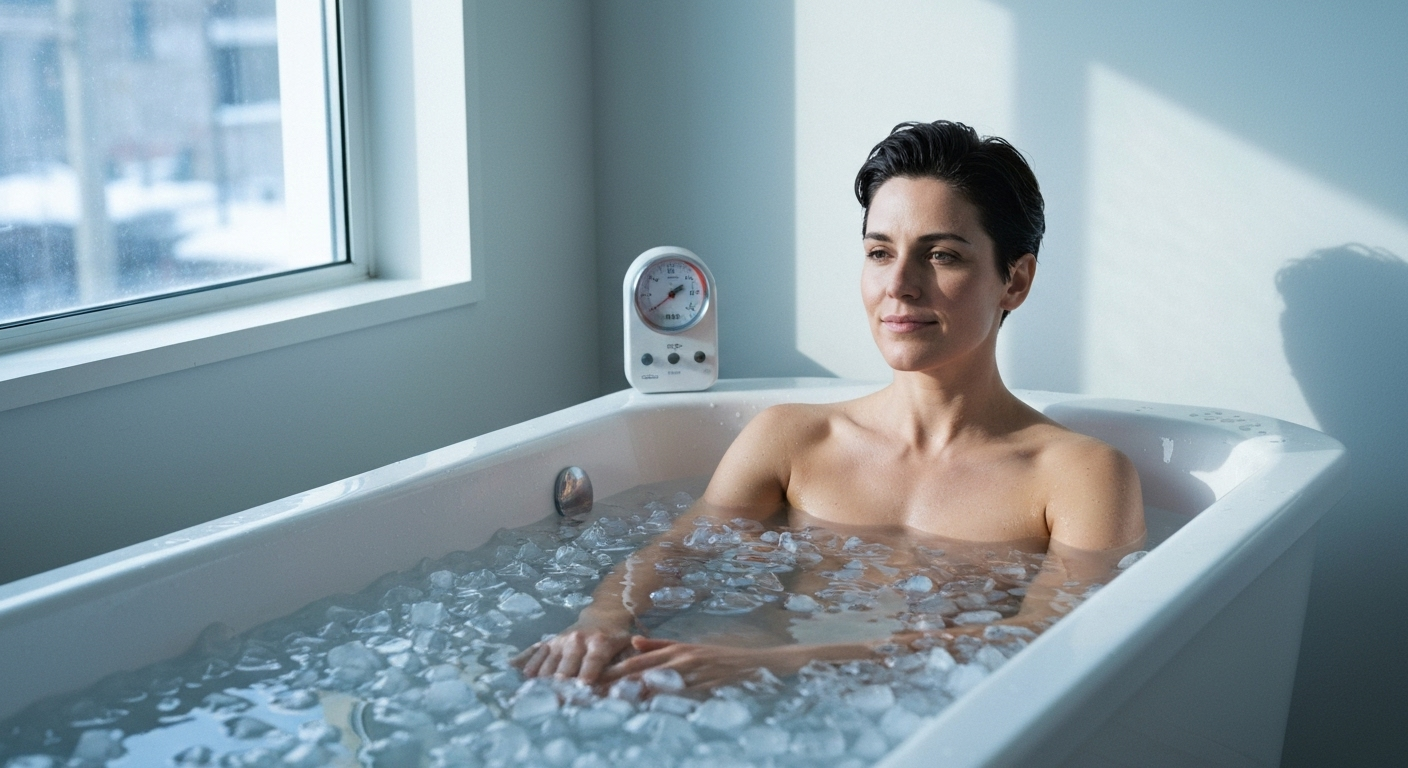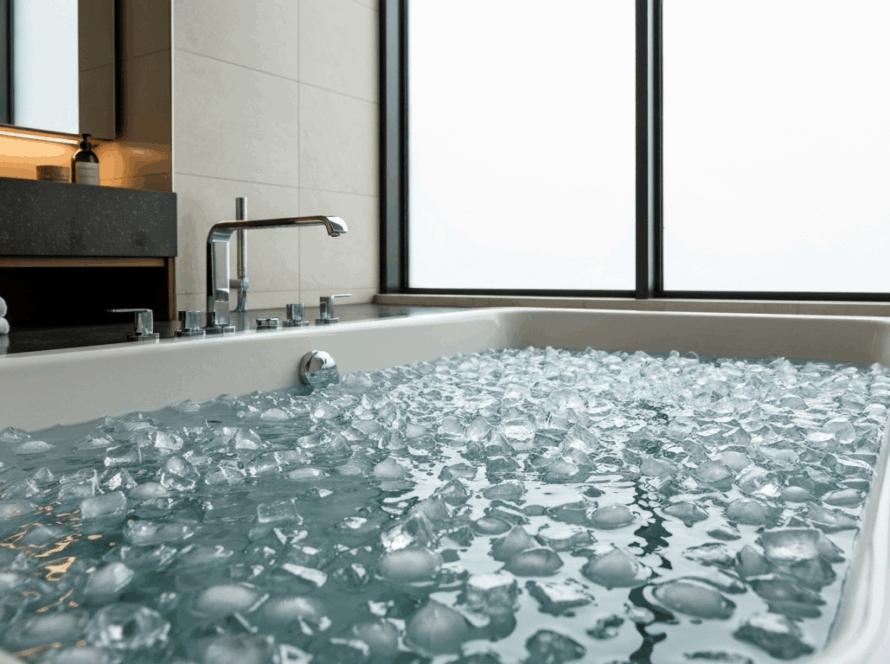Key Highlights
- Cold water immersion is an effective form of cold therapy for managing inflammation and muscle soreness.
- Ice baths work by constricting blood vessels, which reduces swelling and boosts immune system responses.
- Scientific evidence supports using cold therapy for faster recovery and to lessen delayed onset muscle soreness.
- Embracing an ice bath provides numerous health benefits, but it’s crucial to follow safety guidelines.
- For optimal results, use a water temperature of 50-59°F for 3-5 minutes.
- Premium ice baths offer a controlled and effective way to experience inflammation recovery.
Introduction
Have you ever asked if getting into an ice bath helps with swelling in the body? Many athletes and wellness lovers say this cold therapy is not just a fad. It can give some strong health benefits, like better recovery and feeling good overall. This guide will show you how ice baths work and how you can use them to get these health benefits.
Understanding Inflammation and its Impact on Recovery
 Inflammation happens when your body reacts to an injury or very hard workout. This is called the inflammatory response. It is a natural part of the healing process. But, if it goes on too long or gets too strong, it can slow down muscle recovery and hurt your exercise performance.
Inflammation happens when your body reacts to an injury or very hard workout. This is called the inflammatory response. It is a natural part of the healing process. But, if it goes on too long or gets too strong, it can slow down muscle recovery and hurt your exercise performance.
It is important to know the difference between good and bad inflammation if you want to get the most out of your recovery. So, let’s talk about what inflammation is, the kinds that there are, and how it can affect your body after physical activity or intense exercise.
What Is Inflammation and Why Does It Occur?
So, what is inflammation? The immune system uses this as a first line of defense. If the body faces harm, like muscle tears you get from work or an injury, it starts an inflammatory response. This way, the immune system tries to repair what is hurt.
The body goes through physiological changes during this process. It sends more blood and immune cells to the area that needs help. These immune system cells help keep the tissue safe and work to heal you. You can think of this as your inside repair crew coming to fix things fast.
Sometimes, you can feel some discomfort when this happens. But this shows the body is doing what it should. The most important thing is to manage the inflammatory response, so it does not make it harder for you to get better.
Types of Inflammation: Acute vs. Chronic
Inflammation can be divided into two main types. There is acute inflammation and chronic inflammation. Acute inflammation is the kind you get right after a hard workout. This can cause swelling and soreness. The body sends this signal to show that it is healing.
But sometimes, the body does not turn off this reaction. When this happens, it leads to chronic inflammation. This low-level reaction lasts a long time. It has been linked to chronic conditions like heart disease and obesity. You may also notice that your inflammatory markers are higher when this problem is there.
It is important for all of us to manage chronic inflammation, as it can affect long-term health. Many people use ice baths to help with acute problems, but some research says ice baths might also be good for symptoms linked to some chronic conditions.
Common Symptoms and Effects of Inflammation
You may have felt the effects of inflammation, but you might not even know it. The main signs usually show up after you do tough physical activity. This is when your muscles try to fix themselves. You can feel discomfort that can mess up your day and make it hard to get back to your next workout.
Some of the things you notice most are:
- Muscle pain and stiffness
- Swelling you can see in the area that hurts
- Sore muscles, and they are tender if you touch them
- Delayed onset muscle soreness (DOMS), which gets worse 24-48 hours after you exercise
All these signs come from the body’s process of inflammation. A good recovery plan can lower this discomfort so you can get back to moving and working out faster.
The Basics of Ice Bath Therapy
Ice bath therapy is called cold water immersion too. This is a simple way to use cold therapy. You just sit or lie in icy water for some time. The cold water helps start a healing process in your body. The water temperature and how long you stay in decide how well it works.

Are you interested in how ice baths work and where this idea started? Let’s talk about the basics of ice baths and find out what the science says about the benefits of cold water immersion.
What Is an Ice Bath and How Does It Work?
An ice bath is just what the name says. You fill a tub with cold water and ice cubes. The idea is to lower your body temperature. Most people use water that is cool, between 37-59°. They stay in for about 5 to 15 minutes.
When you use water immersion in an ice bath, your blood vessels get smaller for a while. This makes it so less blood flows to your muscles. Doing this helps cut down swelling and any inflammation quickly.
After you get out of the cold water and start to get warm again, your blood vessels open up. Then, fresh blood with oxygen moves into your muscles. This helps push out old waste in your muscles and starts your recovery.
History and Popularity of Cold Bath Inflammation Treatments
Using cold water to help the body is not a new thing. People in many parts of the world have used cold water immersion for a long time because they believe it helps heal the body. Right now, the cold plunge has become very popular again, mostly in sports medicine and health circles.
Many big-name athletes and other well-known people talk about how cold therapy has helped them. The modern trend comes from ideas like the Wim Hof Method. This method brings cold exposure and special ways of breathing together.
A lot of people say cold water immersion works well for them. When people use ice baths, they usually want to:
- Help with pain and stress
- Get better recovery after working out
- Feel better overall
Scientific Principles Behind Soaking in Ice Cold Water
The science behind soaking in ice water is really interesting. When you put your body in cold temperatures, it causes a quick reaction inside your cells. The cold receptors in your skin send fast electrical signals to your brain. This is what people call the cold shock response.
During this response, your heart rate and breathing go up. Then, as you spend more time in the cold, your body learns to keep these things steady. The stress from cold exposure helps make you stronger in the long run.
Cold exposure trains your body down to its cells. This triggers changes that lower inflammation, make your blood flow better, and help out your nervous system. Over time, these things can lead to good health benefits like better circulation and stronger nerves.
Mechanisms: How Ice Bath effect Inflammation
 How does sitting in cold water help cut down on inflammation? The main ways this happens are by changing your blood flow and by how your cells react to cold. The effects of cold water immersion on your blood vessels start right away and can be very strong. This helps slow down muscle damage.
How does sitting in cold water help cut down on inflammation? The main ways this happens are by changing your blood flow and by how your cells react to cold. The effects of cold water immersion on your blood vessels start right away and can be very strong. This helps slow down muscle damage.
Knowing how these things work helps you see why this water immersion therapy works so well for recovery. Now, let’s look at what happens in your body during an ice bath and how cold water affects you inside.
Vasoconstriction and Cellular Response in Ice Cold Water Bath
When you step into a bath with cold water, your blood vessels get smaller right away. This action is called vasoconstriction. It moves blood away from your arms and legs and brings it closer to your body’s core. This helps keep your body temperature steady.
The blood flow going down for a short time has a big benefit. It makes swelling and inflammation in your muscles less, which is one big reason people feel muscle soreness after they work out.
When you come out of the cold bath, your blood vessels get bigger again. This is called vasodilation. Blood full of nutrients goes back to your muscles fast. It helps clear out waste left from working out and makes your muscles heal quicker.
Modulation of Cytokines and Immune Function
Ice baths do more than change blood flow. They also have an effect on your immune system. When you get cold exposure, it boosts how active your white blood cells are. T-lymphocytes are some of these cells, and they are important for the way your body handles inflammatory response.
These white blood cells take care of cytokines. Cytokines are proteins that send out signals about inflammation. After resistance exercise, some cytokines can make your body have too much inflammation. Cold therapy keeps this balanced, so the reaction does not get too strong.
Taking an ice bath works like a switch for your immune system. It helps your body know when to use inflammation to heal without letting it get out of hand. This can help you recover now, and it may also keep your immune system healthy for a long time.
Reducing Muscle Soreness After Exercise with Ice Bath Treatment
One of the top things people love about ice baths is how they help cut down muscle soreness after a hard workout. This is key for dealing with delayed onset muscle soreness (DOMS), which is the pain you get one or two days after you exercise.
Ice baths help by lowering swelling and moving waste out of your muscles, so you get faster exercise recovery. It’s a better method than just doing normal active recovery.
Here’s what an ice bath does:
- It quickly cuts swelling and stops tissue from breaking down.
- It makes your nerve endings numb, so you feel relief from pain right away.
- It helps blood flow better after the bath, which lets healing nutrients reach your muscles.
Ice baths are useful for muscle soreness and help with both muscle pain and delayed onset muscle soreness. These can give your body a good way to recover and help you get ready for your next exercise.
Evidence from Research: Do Ice Bath Reduce Inflammation?
There is solid proof that ice baths work. Many studies now show the effects of cold water immersion on the body, especially when it comes to reducing swelling and helping people recover. Scientists have looked at this using many ways. This goes from small tests to large reviews. You can find these studies on Google Scholar.
This research helps us see how ice baths give benefits to the body. Now, let’s look at some important results. We will also compare cold water immersion and ice baths to other common ways people try to recover.
Soaking in Ice Water: Key Studies for Recovery
Numerous studies have confirmed the benefits of ice baths for elite athletes and everyday fitness enthusiasts alike. For instance, a 2018 systematic review in Frontiers in Physiology analyzed multiple studies and concluded that cold water immersion is an effective technique for reducing delayed onset muscle soreness.
Another study published in the European Journal of Applied Physiology found that cold therapy helps reduce post-exercise inflammation. These findings show a consistent pattern of positive results.
Here is a look at a key finding:
| Study/Review Type | Key Finding |
|---|---|
| 2021 Systematic Review of 32 Trials | Cold water immersion one hour after exercise reduced muscle pain and improved recovery for up to 24 hours. |
Comparing a Cold Bath to Other Cold Therapy Methods
A cold plunge in an ice bath is a great way to try cold water and cold therapy. But it is not the only way. There are other methods. These can help with inflammation and recovery, too. Some ways are not as strong, but still good. How do these methods compare to a classic ice bath?
Each way to use cold exposure or cold therapy has benefits.
- Cold showers: This is easy for most people to do. It can help you get used to cold exposure. But it is not as deep and strong as a cold plunge.
- Contrast water therapy: You switch between cold water and hot water. This makes your blood vessels work hard and helps boost circulation in your body.
- Wim Hof Method: This uses cold exposure with ways of breathing. It is meant to help the nervous system and the immune response.
All these methods have good points. The ice bath, with its full cold plunge, gives the most direct help for swelling and has a strong effect on the blood vessels and body.
The Role of Temperature and Duration in Results
To get the best results from steps like water immersion or an ice bath, you have to make sure things like water temperature and how long you stay in are just right. These two are the most important things that shape how effects of cold water immersion work for you.
Most research shows that cold water immersion works best at a water temperature between 50 and 59 degrees Fahrenheit (that’s 10-15°C). It’s not always better if the water is colder, and going colder can bring extra risks.
Try to keep your soak anywhere from 5 to 15 minutes. If you stay in the cold water too long, it can be risky. But if your time is too short, you may not get the benefits you want from cold water immersion. Use these water temperature and timing tips to help make sure your cold water sessions are good and safe for you.
Safe Practices for Taking Cold Baths for Inflammation
While it is clear that cold exposure can have some health benefits, it is important to use it in a safe way. Jumping right into an ice bath without getting ready can make your body feel shocked. If you follow a few simple safety tips, you can get the most out of cold exposure and lower any risks.
Are you thinking about trying it for yourself? Let’s talk about the basic rules and who should be careful when trying this kind of therapy.
Recommended Temperature and Timing for Recovery
Consistency is important in water immersion. You need to keep the same water temperature and timing for the best results. It helps you get the anti-inflammatory benefit and stay safe. Try not to change what works best.
With cold water immersion, you should aim for a water temperature between 50-59°F (10-15°C). You will want to use a thermometer to check that the water is at the right temperature. The best time to get into cold water is right after your workout, within one hour. This is so you can stop swelling before it gets worse.
Here are some basic rules to follow:
- Temperature: 50-59°F (10-15°C).
- Duration: Stay in for 3-5 minutes each time.
- Frequency: Get into cold water after hard workouts or a couple times a week for wellness.
Step-by-Step Guide to Explore Ice Bath Safely
Getting ready for your first ice bath can be easy if you follow a quick process. This way, your first time in cold water will feel safer and better. Go slow and pay attention to how you feel.
Set up your area before you start. Make sure all you need to use is close by, so you can breathe and try to relax as you step into cold exposure. If you have never done this, it helps to have someone close to watch you.
Here are some tips to stay safe when you use cold water:
- Put cold water in your tub, then add ice cubes little by little until you reach the right temperature.
- Set a timer so you soak for only 2-3 minutes the first few times.
- Go in slowly, so your body gets time to adjust.
- When your timer beeps, get out with care, dry off, and use a towel or robe to warm up.
Who Should Not Use Cold Bath for Inflammation?
Ice baths can be the good way to help your body, but they are not for everyone. Jumping into cold water can be tough on the heart and blood. If you have chronic conditions, it might be risky.
If you are worried about your health, you should talk to your doctor before you try cold water immersion or ice baths. Your doctor can help you know if this treatment is safe for you.
You should not try ice baths if you have:
- Heart disease or have had heart problems
- High blood pressure
- Blood flow conditions like Raynaud’s syndrome
- Cold urticaria, which is getting hives from being cold
Eco Hearth Premium Ice Baths: Features for Optimal Recovery
To get the most from ice baths, you need to have the right setup. Sure, you can use a bathtub filled with ice, but a special cold plunge tub is better. It’s more helpful for things like muscle recovery and controlling inflammation.
Eco Hearth premium ice baths are made to give you a safe and steady cold therapy session each time. You will see how the right features can make your cold plunge and muscle recovery better. With the right setup, you can get all the benefits of ice baths.
Our baths are built with medical-grade stainless steel on the inside for maximum hygiene and durability. The exterior uses thermowood panels, giving you a warm natural look that fits beautifully into premium home gyms, spas, and outdoor wellness spaces. It’s a combination of sleek modern design and natural warmth — strong, long-lasting, and resistant to moisture and outdoor conditions.
Benefits of Eco Hearth’s Ice Bath for Inflammation Relief
The way your ice bath is made is important. An Eco Hearth premium ice bath helps provide better relief from inflammation and makes your cold-water exposure more effective than simply filling a bathtub with ice. With smart temperature management, you get precise, consistent control so the water always stays at the ideal level for fighting muscle soreness. UV water purification keeps the system hygienic between sessions, and remote operation via Wi-Fi lets you pre-cool, adjust settings, and monitor performance from your phone.
You can’t get this level of control with a regular bathtub and a few ice bags. Eco Hearth tubs are built for purpose: they deliver the same cold water profile every time, which is crucial for physical therapy and recovery—so you get reliable, repeatable results with each session.
Key design benefits include:
- Consistent Temperature: You keep the right water temperature all the time, so you get the most anti-inflammatory effects.
- Durable & Hygienic: It is strong, easy to clean, and lasts long because it is made with good materials.
- Ergonomic Comfort: You can sit inside the tub easily in comfort, making it simple to relax and work on your recovery.
Why Eco Hearth Is the Smart Choice for Bathing with Ice Cold Water
Choosing an Eco Hearth ice bath is a smart way to invest in your health and how well you do in physical activity. If you care about muscle recovery after you work hard, you want something that works every time. Eco Hearth gives you a strong cold therapy experience right in your own home.
You do not have to guess the water temperature or go out and buy ice all the time. An Eco Hearth ice bath gives you the right temperature and makes cold therapy easy. You can keep it as part of your daily routine without any stress.
With this, every cold therapy session is safe and good for you. It is made so you recover faster after tough physical activity. You can feel your best every day with it. If you want to get the most out of cold therapy, this option from Eco Hearth is your best bet for muscle recovery and water temperature control.
Conclusion
To sum up, ice bath therapy is a good way to help with inflammation and help you recover after workouts. The science shows that cold exposure changes the way your body works. You can use ice baths to lower muscle soreness and help your immune system, so you recover faster. If you want to add ice baths to your routine, Eco Hearth makes top-quality models for the best recovery. Eco Hearth puts your safety and comfort first. This makes them a great pick for your ice bath needs. If you want more info or need a personal tip, reach out to us today!
Frequently Asked Questions
How do ice baths help reduce inflammation in the body?
Ice baths help lower inflammation. The cold water makes blood vessels get smaller. This stops too much swelling and reduces the body’s response to injury. Cold water immersion also clears out waste from muscles. This can ease muscle soreness and help the immune system repair and heal.
Are ice baths effective for managing chronic inflammation?
Some studies say that cold water immersion may help with problems from chronic conditions like rheumatoid arthritis. More research is needed, so the facts are not all clear yet. If you want to use cold water or cold therapy to help with lasting inflammation, you should talk to your doctor first. This way, you can get health benefits and make sure the way you use water immersion is good for your body.
What is the recommended duration and temperature for an ice bath to help with inflammation?
For good cold water immersion, the water temperature should be between 50 to 59 degrees Fahrenheit. This helps you get the best results. Try to stay in the cold water for around 5 to 15 minutes. It is better to do this within one hour after you finish your physical activity. Cold water immersion like this can help you recover and feel better.
Who should avoid ice baths when dealing with inflammation?
People who have health problems like heart disease or high blood pressure should not take ice baths. The cold exposure may put stress on you and on your heart and on your blood pressure. If you have these or other health issues, talk with your doctor first. It’s important to be sure this kind of cold exposure is safe for you.
- The Journal of Emergencies, Trauma, and Shock. (n.d.). Retrieved October 7, 2025, from https://journals.lww.com/onlinejets/pages/default.aspx
- Stephens, J. M. (2017). Is the ice bath finally melting? Cold water immersion is no greater than active recovery upon local and systemic inflammatory cellular stress in humans. The Journal of Physiology, 595(3), 695–711. https://www.ncbi.nlm.nih.gov/pmc/articles/PMC5350472/


